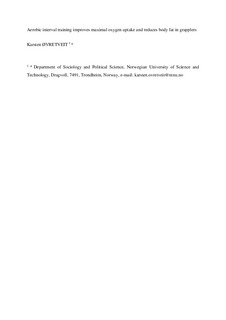| dc.contributor.author | Øvretveit, Karsten | |
| dc.date.accessioned | 2020-01-20T09:45:15Z | |
| dc.date.available | 2020-01-20T09:45:15Z | |
| dc.date.created | 2019-05-07T14:10:27Z | |
| dc.date.issued | 2019 | |
| dc.identifier.issn | 0022-4707 | |
| dc.identifier.uri | http://hdl.handle.net/11250/2636956 | |
| dc.description.abstract | BACKGROUND: Despite regularly engaging in high-intensity grappling, Brazilian jiu-jitsu (BJJ) athletes have a moderate maximal oxygen uptake (V̇O2max). The aim of this study was to evaluate the efficacy and feasibility of high-intensity aerobic interval training as an accessory to BJJ training for improvements in V̇O2max.METHODS: Twelve active male BJJ practitioners (age: 30.3±4.0 [SD] years; height: 183.0±5.3 cm; body mass: 82.7±8.3 kg; body fat: 11.9±3.8%) with 5.6±5.8 years of experience and a training volume of 9.9±4.6 hours·week-1 were randomly allocated to either a training group (TG) or control group (CG). The TG incorporated two high-intensity aerobic interval training sessions·week-1 comprising four 4-minute intervals at 85-95% of maximal heart rate (HRmax) separated by 3-minute active breaks at 70% of HRmax. RESULTS: After six weeks, the TG increased their V̇O2max by 8±3% (95% CI=3.84, 12.73; P=0.04; ES=0.64), from 52.7 to 56.8 mL·kg-1·min-1. This was accompanied by a 1±1% reduction in absolute body fat (95% CI=-0.13, -2.2; P=0.04; ES=0.64). No changes in V̇O2max (P=0.12) or body composition (P=0.34) were detected in the CG. CONCLUSIONS: These findings reveal compelling short-term effects of low-volume high-intensity aerobic interval training on V̇O2max and body composition in active BJJ athletes. There may be a ceiling effect in terms of developing V̇O2max in supine, intermittent grappling sports, making alternative approaches to aerobic conditioning particularly relevant for this athlete population. | nb_NO |
| dc.language.iso | eng | nb_NO |
| dc.publisher | Edizioni Minerva Medica | nb_NO |
| dc.title | Aerobic interval training improves maximal oxygen uptake and reduces body fat in grapplers | nb_NO |
| dc.type | Journal article | nb_NO |
| dc.type | Peer reviewed | nb_NO |
| dc.description.version | acceptedVersion | nb_NO |
| dc.source.journal | Journal of Sports Medicine and Physical Fitness | nb_NO |
| dc.identifier.doi | 10.23736/S0022-4707.19.09584-7 | |
| dc.identifier.cristin | 1696122 | |
| dc.description.localcode | © 2019. This is the authors' accepted and refereed manuscript to the chapter. Locked until 30.04.2020 due to copyright restrictions. The final authenticated version is available online at: 10.23736/S0022-4707.19.09584-7 | nb_NO |
| cristin.unitcode | 194,67,25,0 | |
| cristin.unitname | Institutt for sosiologi og statsvitenskap | |
| cristin.ispublished | true | |
| cristin.fulltext | postprint | |
| cristin.qualitycode | 1 | |
